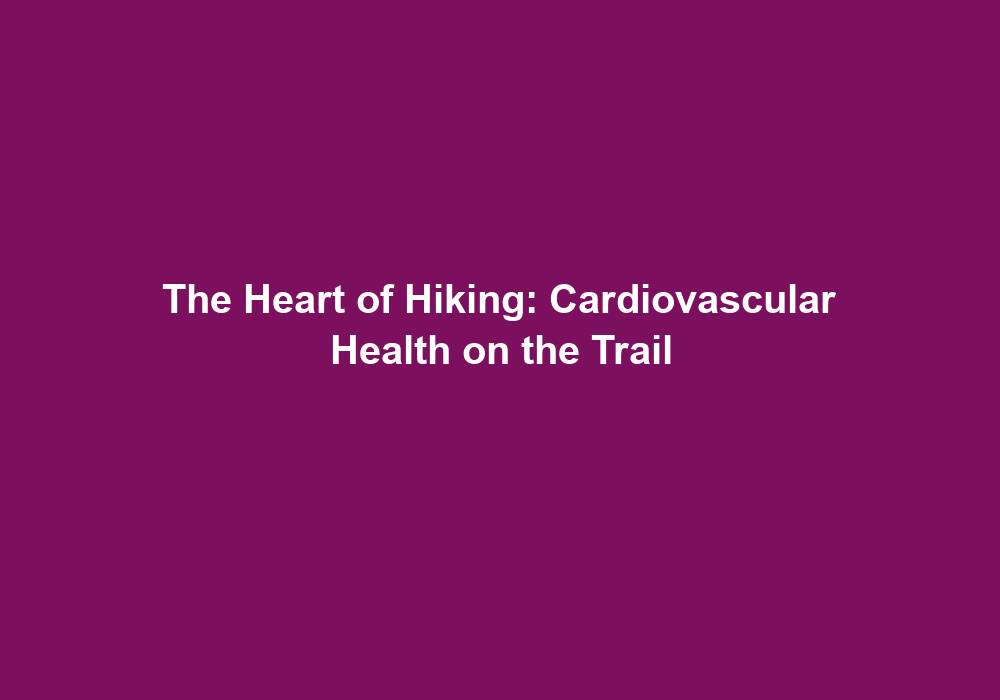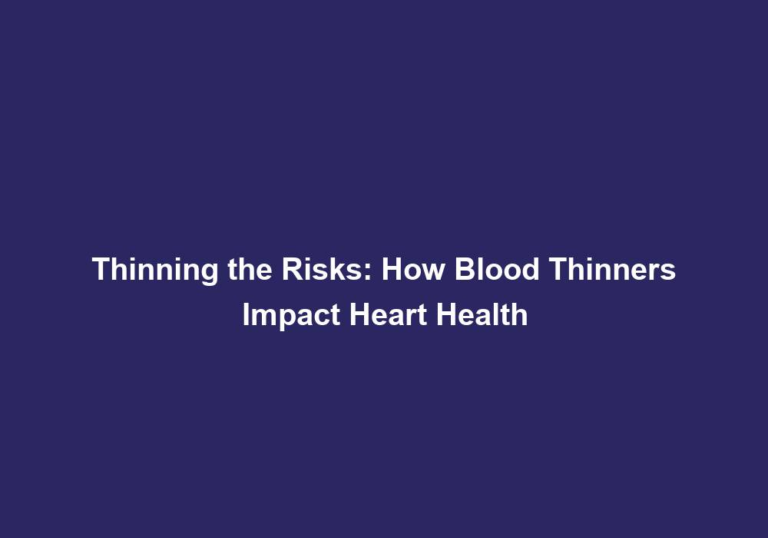The Heart of Hiking: Cardiovascular Health on the Trail
Hiking offers numerous benefits for both the mind and body. It is not only a great way to explore nature and enjoy breathtaking views but also an excellent form of exercise that promotes cardiovascular health. Engaging in regular hiking can significantly improve your overall fitness levels, boost your stamina, and strengthen your heart. In this article, we will delve deeper into the ways hiking benefits cardiovascular health and share some tips to make the most out of your hiking experience.
Understanding Cardiovascular Health
Before diving into the cardiovascular benefits of hiking, let’s have a brief understanding of what cardiovascular health entails. The cardiovascular system consists of the heart, blood vessels, and blood. It plays a vital role in transporting oxygen, nutrients, and hormones to various parts of the body and removing waste products.
Maintaining a healthy cardiovascular system is crucial for overall well-being. When your heart is strong and efficient, it can pump blood more effectively, ensuring that all your organs receive an adequate supply of oxygen and nutrients.
Hiking and Cardiovascular Health
Hiking is a form of aerobic exercise that gets your heart rate up and increases blood circulation throughout your body. It provides a moderate-intensity cardiovascular workout that can help improve heart health in several ways:
1. Strengthening the Heart
Regular hiking puts your heart to work, thereby strengthening it. As you navigate different terrains and inclines, your heart rate increases, and your cardiovascular system adapts to meet the demands. Over time, this leads to improved heart muscle strength, making it more efficient at pumping blood.
Expanding on this point, hiking involves continuous movement and challenges your heart to work harder. The varying terrains, such as uphill climbs or rocky paths, require your heart to pump blood at a faster rate to supply oxygen to the muscles. This constant cardiovascular workout helps to strengthen the heart muscle, making it more efficient over time. A stronger heart can pump blood with less effort, reducing the risk of heart-related conditions such as heart disease and stroke.
2. Lowering Blood Pressure
Hiking can also help reduce blood pressure levels, making it an ideal activity for individuals with hypertension or high blood pressure. When you engage in aerobic exercise like hiking, your blood vessels expand, allowing blood to flow more freely. This, in turn, helps lower blood pressure and reduces the strain on your heart.
Expanding on this point, hiking triggers the release of nitric oxide in the body, which helps relax and widen blood vessels. As a result, blood flows more smoothly, reducing the pressure on arterial walls and lowering blood pressure. This effect is especially beneficial for individuals with hypertension, as it helps to manage and control their blood pressure levels. Regular hiking can contribute to long-term blood pressure reduction and decrease the risk of cardiovascular diseases associated with high blood pressure.
3. Increasing Stamina and Endurance
While hiking, your body continuously demands energy, improving your stamina and endurance levels. As you challenge yourself with longer hikes or more challenging terrains, your cardiovascular system adapts by increasing its capacity to transport oxygen and nutrients efficiently. This increased endurance can further enhance cardiovascular health.
Expanding on this point, hiking is a great way to improve your overall stamina and endurance. As you gradually increase the intensity and duration of your hikes, your cardiovascular system becomes more efficient at delivering oxygen and nutrients to your muscles. This increased capacity allows you to hike longer distances without feeling fatigued, enhancing your overall cardiovascular health. Improved stamina and endurance also translate into better performance in other physical activities and daily tasks.
4. Burning Calories and Managing Weight
Hiking is a fantastic way to burn calories and manage weight. The varying terrains, inclines, and obstacles encountered during a hike require more energy expenditure compared to walking or running on a flat surface. Regular hiking can help you shed excess pounds, maintain a healthy weight, and reduce the risk of cardiovascular diseases associated with obesity.
Expanding on this point, hiking is a calorie-burning activity that can aid in weight management. The intensity of hiking, especially on challenging terrains, increases your heart rate and engages multiple muscle groups. This results in a higher calorie burn compared to other forms of exercise. Additionally, hiking in nature provides a refreshing and enjoyable experience, making it easier to stick to a regular exercise routine. By incorporating hiking into your fitness regimen, you can achieve and maintain a healthy weight, reducing the strain on your cardiovascular system and minimizing the risk of obesity-related conditions.
5. Reducing the Risk of Heart Disease
Engaging in regular physical activity, such as hiking, is associated with a lower risk of heart disease. Studies have shown that individuals who hike or engage in other moderate-intensity aerobic exercises tend to have a reduced risk of developing heart disease, stroke, and other cardiovascular conditions. Hiking helps maintain healthy cholesterol levels, control blood sugar levels, and improve overall cardiovascular function.
Expanding on this point, hiking has numerous cardiovascular benefits that contribute to reducing the risk of heart disease. Regular hiking helps to manage cholesterol levels by increasing the levels of high-density lipoprotein (HDL) or “good” cholesterol and decreasing the levels of low-density lipoprotein (LDL) or “bad” cholesterol. This balance is crucial for heart health as high levels of LDL cholesterol may lead to the formation of plaque in the arteries, increasing the risk of heart disease. Hiking also helps regulate blood sugar levels, which is important for individuals with diabetes or those at risk of developing the condition. By improving overall cardiovascular function, hiking enhances the efficiency of the heart and blood vessels, reducing the likelihood of cardiovascular diseases.
Tips for Maximizing Cardiovascular Benefits of Hiking
To make the most out of your hiking experience and reap the maximum cardiovascular benefits, here are some tips to consider:
- Start Slow: If you are new to hiking or have been inactive for a while, it is essential to start slowly and gradually increase the intensity and duration of your hikes. This approach allows your body to adapt and reduces the risk of injury.
When starting hiking, it’s important to listen to your body and not push yourself too hard. Begin with shorter, easier hikes before progressing to more challenging trails. This gradual increase in intensity will give your cardiovascular system time to adjust and strengthen, minimizing the risk of overexertion or strain. Starting slow also allows you to build a solid foundation of cardiovascular endurance, ensuring a safe and enjoyable hiking experience.
- Choose Appropriate Trails: Select trails that align with your fitness level and goals. Gradually progress to more challenging terrains as your cardiovascular fitness improves.
When choosing hiking trails, consider your current fitness level and experience. Opt for trails that match your abilities, gradually increasing the difficulty as you become more comfortable and fit. This progression allows your cardiovascular system to adapt and continually improve. It’s important to challenge yourself without overexertion to maximize the cardiovascular benefits of hiking.
- Maintain Proper Form: To optimize the benefits of hiking, maintain a good posture throughout your hike. Engage your core muscles, keep your back straight, and take regular breaks to stretch and relax.
Proper form is essential for maximizing the cardiovascular benefits of hiking. Maintain an upright posture with your shoulders back and your core engaged. This alignment helps distribute the workload evenly throughout your body, preventing unnecessary strain on your cardiovascular system. Regular breaks during your hike allow you to stretch and relax, reducing muscle tension and promoting blood flow. By maintaining proper form and taking breaks, you can hike longer distances and experience greater cardiovascular benefits.
- Stay Hydrated: Proper hydration is crucial during hikes, as it helps maintain optimal cardiovascular function. Carry an adequate amount of water and drink regularly to stay hydrated, especially in hot or humid conditions.
Hydration plays a vital role in supporting cardiovascular health during hiking. When hiking, your body loses water through sweat, and dehydration can negatively impact your heart’s efficiency. Carry an ample supply of water and drink at regular intervals to stay hydrated. In hot or humid conditions, increase your water intake to compensate for additional fluid loss. Adequate hydration ensures that your cardiovascular system can effectively transport oxygen and nutrients, promoting overall cardiovascular health.
- Incorporate Interval Training: To elevate your heart rate and increase the cardiovascular benefits, include interval training during your hikes. Alternate between periods of moderate-paced walking and faster-paced bursts to challenge your cardiovascular system.
Interval training is an effective way to enhance the cardiovascular benefits of hiking. By alternating between periods of moderate-paced walking and faster-paced bursts, you can elevate your heart rate and increase the intensity of your cardiovascular workout. This variation challenges your cardiovascular system, improving its strength and endurance. Interval training also helps burn more calories and improves overall cardiovascular fitness. Incorporate intervals by picking up the pace or incorporating short sprints during your hike, making sure to listen to your body and adjust the intensity as needed.
- Use Trekking Poles: Utilizing trekking poles can help distribute the workload evenly and reduce strain on your joints. This allows you to hike longer and more comfortably, improving the cardiovascular benefits.
Trekking poles are a valuable tool for maximizing the cardiovascular benefits of hiking. They provide additional stability and support, reducing the strain on your joints and muscles. By distributing the workload evenly, trekking poles help alleviate stress on your lower body, allowing you to hike for longer periods without discomfort. This extended hiking time increases the duration and intensity of your cardiovascular workout, enhancing overall cardiovascular health.
- Dress Appropriately: Wear comfortable, moisture-wicking clothing and suitable footwear to prevent discomfort and blisters. Dressing in layers allows you to adjust your clothing as needed during the hike.
Proper attire is essential for a comfortable and enjoyable hiking experience. Choose moisture-wicking clothing that helps keep you dry and comfortable, preventing chafing and irritation. Opt for suitable footwear that provides adequate support and cushioning, reducing the risk of blisters and injuries. Dressing in layers allows you to adjust your clothing to changes in temperature or weather conditions, ensuring optimal comfort throughout your hike. By wearing appropriate attire, you can focus on maximizing the cardiovascular benefits of hiking without distractions or discomfort.
- Listen to Your Body: Pay attention to how your body feels during the hike. If you experience chest pain, dizziness, or shortness of breath, take a break and seek medical attention if necessary. It’s essential to listen to your body’s signals and not push beyond your limits.
Your body’s signals are essential when hiking to ensure the safety of your cardiovascular health. If you experience any concerning symptoms such as chest pain, dizziness, or shortness of breath, it’s crucial to listen to your body and take a break. These symptoms may indicate underlying cardiovascular issues and should not be ignored. Rest, hydrate, and if necessary, seek medical attention to assess your condition. Always prioritize your well-being and don’t push beyond your limits to prevent potential risks to your cardiovascular health.
By implementing these tips, you can optimize the cardiovascular benefits of hiking while enjoying the beauty of nature and exploring new trails.
In conclusion, hiking is a wonderful way to improve cardiovascular health. It strengthens the heart, lowers blood pressure, increases stamina, burns calories, and reduces the risk of heart disease. By incorporating hiking into your regular exercise routine and following the tips mentioned above, you can embark on a journey towards better cardiovascular health. Lace up your boots, hit the trails, and let your heart thank you for it!







